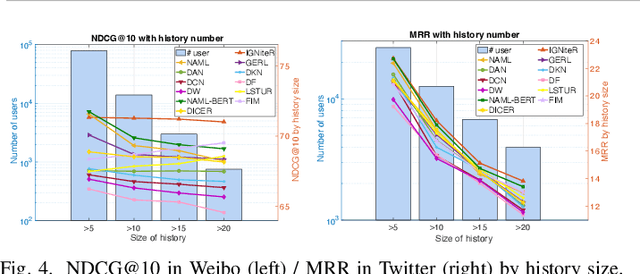Yuting Feng
Influence Maximization via Graph Neural Bandits
Jun 18, 2024Abstract:We consider a ubiquitous scenario in the study of Influence Maximization (IM), in which there is limited knowledge about the topology of the diffusion network. We set the IM problem in a multi-round diffusion campaign, aiming to maximize the number of distinct users that are influenced. Leveraging the capability of bandit algorithms to effectively balance the objectives of exploration and exploitation, as well as the expressivity of neural networks, our study explores the application of neural bandit algorithms to the IM problem. We propose the framework IM-GNB (Influence Maximization with Graph Neural Bandits), where we provide an estimate of the users' probabilities of being influenced by influencers (also known as diffusion seeds). This initial estimate forms the basis for constructing both an exploitation graph and an exploration one. Subsequently, IM-GNB handles the exploration-exploitation tradeoff, by selecting seed nodes in real-time using Graph Convolutional Networks (GCN), in which the pre-estimated graphs are employed to refine the influencers' estimated rewards in each contextual setting. Through extensive experiments on two large real-world datasets, we demonstrate the effectiveness of IM-GNB compared with other baseline methods, significantly improving the spread outcome of such diffusion campaigns, when the underlying network is unknown.
Influence Maximization with Fairness at Scale (Extended Version)
Jun 06, 2023Abstract:In this paper, we revisit the problem of influence maximization with fairness, which aims to select k influential nodes to maximise the spread of information in a network, while ensuring that selected sensitive user attributes are fairly affected, i.e., are proportionally similar between the original network and the affected users. Recent studies on this problem focused only on extremely small networks, hence the challenge remains on how to achieve a scalable solution, applicable to networks with millions or billions of nodes. We propose an approach that is based on learning node representations for fair spread from diffusion cascades, instead of the social connectivity s.t. we can deal with very large graphs. We propose two data-driven approaches: (a) fairness-based participant sampling (FPS), and (b) fairness as context (FAC). Spread related user features, such as the probability of diffusing information to others, are derived from the historical information cascades, using a deep neural network. The extracted features are then used in selecting influencers that maximize the influence spread, while being also fair with respect to the chosen sensitive attributes. In FPS, fairness and cascade length information are considered independently in the decision-making process, while FAC considers these information facets jointly and considers correlations between them. The proposed algorithms are generic and represent the first policy-driven solutions that can be applied to arbitrary sets of sensitive attributes at scale. We evaluate the performance of our solutions on a real-world public dataset (Sina Weibo) and on a hybrid real-synthethic dataset (Digg), which exhibit all the facets that we exploit, namely diffusion network, diffusion traces, and user profiles. These experiments show that our methods outperform the state-the-art solutions in terms of spread, fairness, and scalability.
IGNiteR: News Recommendation in Microblogging Applications (Extended Version)
Oct 04, 2022



Abstract:News recommendation is one of the most challenging tasks in recommender systems, mainly due to the ephemeral relevance of news to users. As social media, and particularly microblogging applications like Twitter or Weibo, gains popularity as platforms for news dissemination, personalized news recommendation in this context becomes a significant challenge. We revisit news recommendation in the microblogging scenario, by taking into consideration social interactions and observations tracing how the information that is up for recommendation spreads in an underlying network. We propose a deep-learning based approach that is diffusion and influence-aware, called Influence-Graph News Recommender (IGNiteR). It is a content-based deep recommendation model that jointly exploits all the data facets that may impact adoption decisions, namely semantics, diffusion-related features pertaining to local and global influence among users, temporal attractiveness, and timeliness, as well as dynamic user preferences. To represent the news, a multi-level attention-based encoder is used to reveal the different interests of users. This news encoder relies on a CNN for the news content and on an attentive LSTM for the diffusion traces. For the latter, by exploiting previously observed news diffusions (cascades) in the microblogging medium, users are mapped to a latent space that captures potential influence on others or susceptibility of being influenced for news adoptions. Similarly, a time-sensitive user encoder enables us to capture the dynamic preferences of users with an attention-based bidirectional LSTM. We perform extensive experiments on two real-world datasets, showing that IGNiteR outperforms the state-of-the-art deep-learning based news recommendation methods.
 Add to Chrome
Add to Chrome Add to Firefox
Add to Firefox Add to Edge
Add to Edge